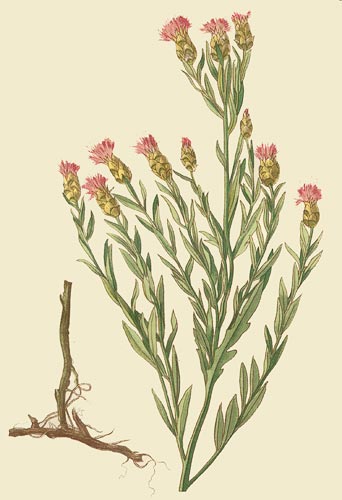Weeds
Acroptilon repens DC. - Russian Knapweed.
Systematic position.
Family Asteraceae (Compositae), genus Acroptilon Cass.Synonyms.
Centaurea repens L, S. picris Pall., Acroptilon picris S. A. M, A.obtusifolium Cass., Serratula picris (Pall.ex Willd.) MB.Biological group.
A summer-green perennial plant that forms offshoots.Morphology and biology.
Root system is well developed. It consists of numerous vertical roots and horizontal rhizomes. Main tap root can reach a depth of 10 m. Old roots are black, dense, ligneous; young roots are white and fragile. Few adventitious roots are located on roots. On the contrary, many additional buds are situated on underground offshoots. Stalk is straight, cobwebby pubescent, ramified almost from base, 20-70 cm tall. Leaves are alternate and sessile; upper leaves are entire. Leaves and stalk are pubescent; therefore the whole plant has a gray-green color. Calathid head (1-1.25 cm in diameter) is located at the end of every branchlet (ramulus) of plant. Involucral leaflets imbricate: External leaflets are rounded, wide, greenish, with white filmy edge; internal leaflets are dense pubescent, narrow, with pointed filmy appendage. All flowers in calathidia are identical, bisexual, and tubular, with pink (sometimes white) nimbus. After flowering the calathidia are closed, and seeds drop out only after destruction of calathidia. Fruit is yellow-green or gray-green short hemicarp with indistinct longitudinal grooves, 3 mm long, squeezed laterally, glabrous, with fragile pappus.Distribution.
The plant originated from Central Asia, and the species has been spreading since the end of the 19th century. Plants are spread when seeds of lucerne are contaminated with knapweed. In the territory of the former USSR the species is distributed now in the southeast of the European part (Maevskii, 1954) and in Crimea (Rubtsov, 1972), in the Caucasus according to Grossgeim (1949) and Takhtadzhyan & Fedorov (1972), Central Asia according to the following sources: in Turkmenistan by Nikitin & Geldikhanov (1988); in Tadjikistan by Komarov (1967); in Kazakhstan by Goloskokov (1972); in Uzbekistan by Khuzhanazarov et al. (2003). It is sparsely populated in the Altai Territory of Western Siberia based on the work of Krasnoborov (1997). Northern border of the weed area in Eurasia is limited to latitude 50° N (to 53° at most). The plant has the highest weediness in the arable lands in the area of its main distribution. General distribution includes: Europe (locally in Germany and Poland), Asia (Afghanistan, Iraq, Iran, China, Mongolia, Syria, Turkey), North America (Canada, the USA), and Australia.Ecology.
Plant grows well on light and heavy clay-soils, being able to sustain solonetzic soils. Plants develop normally in droughty climates and semi-desert zones with an amount of precipitation of 200-375 mm. The species is highly competitive and usually dominates in plant communities (phytocoenosis). It litters fields of all cultures, and also gardens, vineyards, meadows, and pastures; it grows along roads and railways.Economic significance.
The weed is extremely noxious. It causes reduced productivity of cultures; quality of yield (and forages) also falls; and efficiency of pastures weakens. For example, productivity of winter wheat in the Stavropol Territory was reduced by 48% with moderate weediness (26 plants of Knapweed per square meter). If grain is contaminated by the weed, flour tastes bitter. Contaminated hay is poisonous to horses, spoiling the taste of cow.s milk. It is one of the most difficult weeds to eradicate, and is included on the lists of quarantined weeds in many countries (the Russian Federation, Ukraine, Kazakhstan, the USA, and others). The weed depletes water and nutrients from the soil. The weed also produces exudates which slow down the growth and development of other plants.Control measures.
Preventive actions include excluding seed in new regions (together with the seeds of lucerne and clover, with grain, hay, straw, and other materials) through public education; use of pure seeds and rotted manure in agricultural fields; regular inspection of the territory and eradication of primary and isolated centers of the weed. Agronomical actions should be directed to weakening the weed, using periodic pruning of roots. It is necessary to remember that a good result in the struggle against the weed can only be achieved with a combination of agronomical and chemical methods. Application of biological enemies of the weed is also useful. Such biological enemies are Euribia maura Frfld. and E. kasachstanica V.Richter., Dasyneura sp., Eriophyes sp., and Anguina picridis Kir.Reference citations:
Goloskokov V.P., ed. 1972. Illustrated keys to plants of Kazakhstan. V. 2. Alma-Ata: Nauka. 572 pp. (In Russian)Grossgeim A.A. 1949. Keys to plants of the Caucasus. Moscow: Sovetskaya nauka. 747 pp. (In Russian)
Government of Republic Kazakhstan. 2002. The decision from December 10, 2002. N. 1295. About the statement of lists of the objects of quarantine and of the especially dangerous harmful organisms. Quarantine objects which seldom meet in territory of Republic Kazakhstan: http://ru.government.kz/documents/premlaw/12.2002/page05 (In Russian).
Khuzhanazarov U.E., Allanazarova U., Beknazarov B.O., Valikhanov M.N. 2003. Modern condition of a vegetative cover of Chirakchinsky area. http://www.smu.psn.ru (In Russian).
Komarov B.M. 1967. Keys to plants of Northern Tajikistan. Dushanbe: Donish. 400 pp. (In Russian)
Kott S.A. 1955. Weed plants and their control. Moscow: Selkhosgiz. 2nd edition. 384 pp. (In Russian)
Krasnoborov, I.M., ed. 1997. Flora of Siberia. V. 13. Novosibirsk: Nauka. 472 pp. (In Russian)
Maevskii, P.F. 1954. Flora of middle belt of the European part of the USSR. Moscow-Leningrad: Selkhosgiz. 912 pp. (In Russian)
Maltsev A.I. 1937. Atlas of the major species of weed plants of the USSR. V. 1. Moscow-Leningrad: Selkhosgiz. 168 pp. (In Russian)
Moskalenko G.P. 2001. Quarantine weeds of Russia. Moscow: Rosgoskarantin. 280 pp. (In Russian)
Nikitin V.V., Geldikhanov A.M. 1988. Keys to plants of Turkmenistan. Leningrad: Nauka. 680 pp. (In Russian)
Ovesnov S.A. 1997. Synopsis of flora of the Perm Region. Perm: Publishing house of the Perm University. 252 pp. (In Russian)
Rubtsov N.I., ed. 1972. Keys to vascular plants of the Crimea. Leningrad: Nauka. 552 pp. (In Russian)
Takhtadzhyan, A.L. & A.A. Fedorov. 1972. Flora of Erevan. Leningrad: Nauka. 396 pp. (In Russian)


